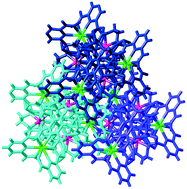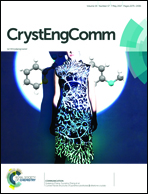Chiral discrimination in solid-state interactions of cobalt(iii)–polyamine complex cations with tris-(dipicolinato)lanthanate(iii) anions†
Abstract
Structural characterisation of a further series of crystalline solids in which [Ln(dipic)3]3− anions (dipic = pyridine-2,6-dicarboxylate; Ln = La, Gd) are accompanied by chiral Co(III)-containing cations provides new examples of layered lattices where sheets of anions and (cations + water) alternate. Δ,Λ-[Co(en)3]3+ (en = ethane-1,2-diamine) forms crystals where, depending on the degree of hydration, the cation sheets are either homo- or heterochiral but the anion sheets are always heterochiral. Δ-[Co(en)3]3+ provides lattices where the anion sheets remain heterochiral, resulting in unusual solids containing a single enantiomer of the cation along with both enantiomers of the chiral anion, rather than two diastereomeric crystals containing the separate anions. Classical resolution of the anions only appears to occur in the presence of a functionalised cage amine complex cation, Δ-[Co((NO2)2sar)]3+ (sar = sarcophagine = 3,6,10,13,16,19-hexa-azabicyclo[6.6.6]icosane) which gives crystals in which direct H-bonding interactions between the cations and anions are surprisingly limited and the success of the resolution requires consideration of a variety of other factors.



 Please wait while we load your content...
Please wait while we load your content...